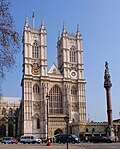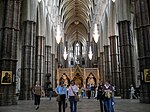The Unknown Warrior
1920 in the United Kingdom1920 sculpturesBritish military personnel killed in World War IBurials at Westminster AbbeyDate of birth unknown ... and 5 more
Military memorials in LondonRecipients of the Medal of HonorTombs of Unknown SoldiersUse British English from June 2012World War I memorials in the United Kingdom

The British grave of the Unknown Warrior (often known as 'The Tomb of The Unknown Warrior') holds an unidentified member of the British armed forces killed on a European battlefield during the First World War. He was buried in Westminster Abbey, London on 11 November 1920, simultaneously with a similar interment of a French unknown soldier at the Arc de Triomphe in France, making both graves the first to honour the unknown dead of the First World War. It is the first example of a tomb of the Unknown Soldier.
Excerpt from the Wikipedia article The Unknown Warrior (License: CC BY-SA 3.0, Authors, Images).The Unknown Warrior
Dean's Yard, London Millbank
Geographical coordinates (GPS) Address Website Nearby Places Show on map
Geographical coordinates (GPS)
| Latitude | Longitude |
|---|---|
| N 51.499444444444 ° | E -0.1275 ° |
Address
Westminster Abbey
Dean's Yard 20
SW1P 3PA London, Millbank
England, United Kingdom
Open on Google Maps








